





Uchenna Ogemdi Okwuosa, Oscar Philander
ORCID ID: 0000-0003-1779-935X, 0000-0002-6702-6913
Adaptronics AMTL
Cape Peninsula University of Technology
Cape Town
South Africa
A major manifestation of the Covid-19 virus is acute respiratory syndrome. This brought about the massive need for respiratory support devices. The pandemic caused shortages of these critical devices, such as PEEP valves, which every ventilator must have to make supporting Covid-19 patients possible. PEEP valves are used to create a positive exhalation end pressure to prevent the patient’s lungs from collapsing. This paper presents the developed a CATPUL PEEP valve designed to meet the South African and African continent markets. The CAD model of an AmbuPEEP valve and the CATPUL was designed with SolidWorks and CFD analysis was performed using Simscale software to characterise and compare the results of the two valves. The result of Ambu valve at 2mm valve opening was 1931 Pa pressure and 29.74 m/s maximum flow velocity. The CATPUL recorded a maximum pressure of 1937 Pa and 29.77 m/s maximum velocity at the same valve opening. This shows that the designed valve outperformed the one on the market in terms of flow across the valve based on the computational analysis.
Keywords: PEEP, valve, CFD, Covid-19, Expiratory, Exhalation, Lungs, alveoli.
| CAD | Computer Aided Design |
| CPAP | Continuous Positive Airway Pressure |
| PEEP | Positive End Expiratory Pressure |
| D | Diameter |
| d | Diameter |
| CFD | Computational Fluid Dynamics |
Resuscitating equipment is highly needed in an emergency facing health care systems all over the world. The outbreak of Covid-19 made these obvious and exposed deficiencies and unpreparedness in responding adequately to the demands of respiratory support. The unforeseen pandemic caused a shortage of ventilators and other respiratory support devices. These still mounting pressures on health care facilities all over the world is causing a global scramble for these limited supplies (Brierley, 2020). The South African Minister of Trade and Industry identified continuous positive airway pressure (CPAP) respiratory support device as important and critical to save lives in South Africa (Roelf, 2020). This assertion was made due to the nature of respiratory support needs arising from coronavirus infection. CPAP is needed to keep the lungs of a Covid-19 patient open to allow easy breathing by generating positive end expiratory pressure (PEEP) (Meara, 2020). Meara reported the importance of CPAP in combating Covid-19. Among them is its use at the early stages of infection to improve respiratory conditions. This will prevent critical situations requiring invasive devices. This report was corroborated by the research work done by Ashish et al. (2020). CPAP gained attention due to its ability to generate PEEP on a continuous basis to prevent the lungs from collapsing. This is particularly needed when about 15% of the Covid-19 patients need oxygen therapy and 5% will be critically ill as reported by Schutz, (2020).
Positive End Expiratory Pressure (PEEP) valves, as reported by McEvoy (2020), have been in existence since 1938. It has played a great role in the treatment and management of patients suffering from acute respiratory syndrome (Harman, 2020). The success and its usefulness are being amplified during the Covid-19 pandemic as an add-on to the mechanical ventilator to improve oxygenation of patients (Mason, 2014).
Prior to the Covid-19 pandemic, the African continent had no local capabilities to design and manufacture this device. This, as observed by the author, left the continent to the mercy of the West for the supply of this device. Due to the global shortage, companies like (EPCM: an engineering design and project management company), CapeWell, etc. (EPCM, 2020), institutionally based research centres (TIA Adaptronic AMTL: a research centre in CPUT, etc.), groups (Umoya, etc.), companies (EPCM and Medical Marine Offshore, etc. and individuals in South Africa (Roelf, 2020), and other African countries like Rwanda (Xinhua, 2020), swiftly sprang into action to produce ventilators and accessories in response to the challenge. This actionable response sees some of these companies’ producing ventilators and accessories using locally sourced materials and skills.
To ensure adequate internal response, the South African government rolled out research and development funds towards developing local capabilities. All these efforts culminated into Umoya developing an adjustable PEEP valve and ventilator. Capewell, on the other, hand focuses on the spring of the PEEP valve using fundsfrom the South African government (PtSA, 2020). As part of South African agencies'response to the demand of PEEP valves, merSETA is currently funding a capacity building project meant to equip learners with the skills needed to respond effectively to produce medical related devices, including the PEEP valve.
Different parties, including researchers around the world, in an attempt better tackle the Covid- 19 virus, developed PEEP valves adaptable to different ventilators. The inline PEEP valve from Bunting et al. (2020) was used on a differential multiventilator to maintain adequate positive pressure at the exhalation end without venting the air to the atmosphere. During the development of a ventilator, Boire et al. (2021) also developed a solenoid-controlled PEEP valve with a record maximum performance error of 0.1 cmH2O during testing. However, considering the airways resistive pressure drop, the study by Hartung et al. (2016) to determine the errors on the existing PEEP valves, shows that the error in the PEEP ranges between 1.8 and 6.2 cmH2O and it is proportional to operating time and pressure. On the sensitivity of the valve to flow rate with respect to age, the work of Hawkes et al. (2011) shows that a Neopuff valve is sensitive to flowrate and warn that users/operators must pay attention to set the patient's PEEP needs accurately.
A replica CAD model of an Ambu PEEP valve and the developed valve was designed in SolidWorks to a high degree of accuracy as shown in Figure 1 and Figure 2, respectively. These valves were characterised using Simscale CFD software. The basic differential features of these valves are seen at the upper part of the valves.

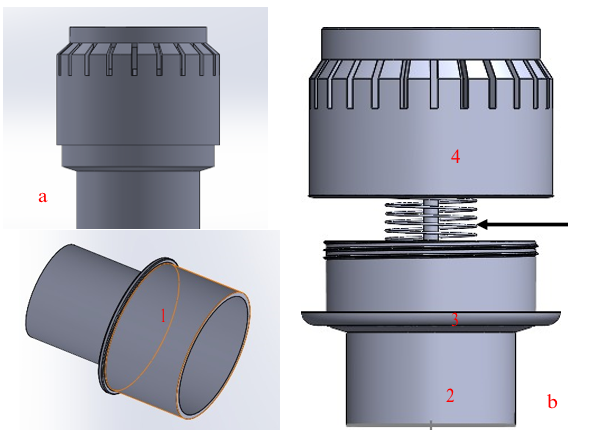
i. Functional description of the CAPTUL PEEP valve
The valve is used depending on the patient socket or the ventilator fitting with or without a design adaptor (component 1). During operation, the valve is set according to the patient's needs by adjusting the upper part (component 4) which screws through component 2. The calibration is placed on the body of the component and setting is done by adjusting the upper half until the bottom part of the valve lock (component 3) coincides with the calibration line desired.
ii. CAPTUL PEEP valve development overview
Figure 3 shows the development processes considered during the development of this device. It shows the different stages of the development ranging from CAD design, the engineering analysis process, the prototyping stage, manufacturing (two stages: 3D printing and Injection moulding) and then the testing of the device. The processes between the CAD design and the engineering analysis involved some iterative steps until the desired flow result was achieved.
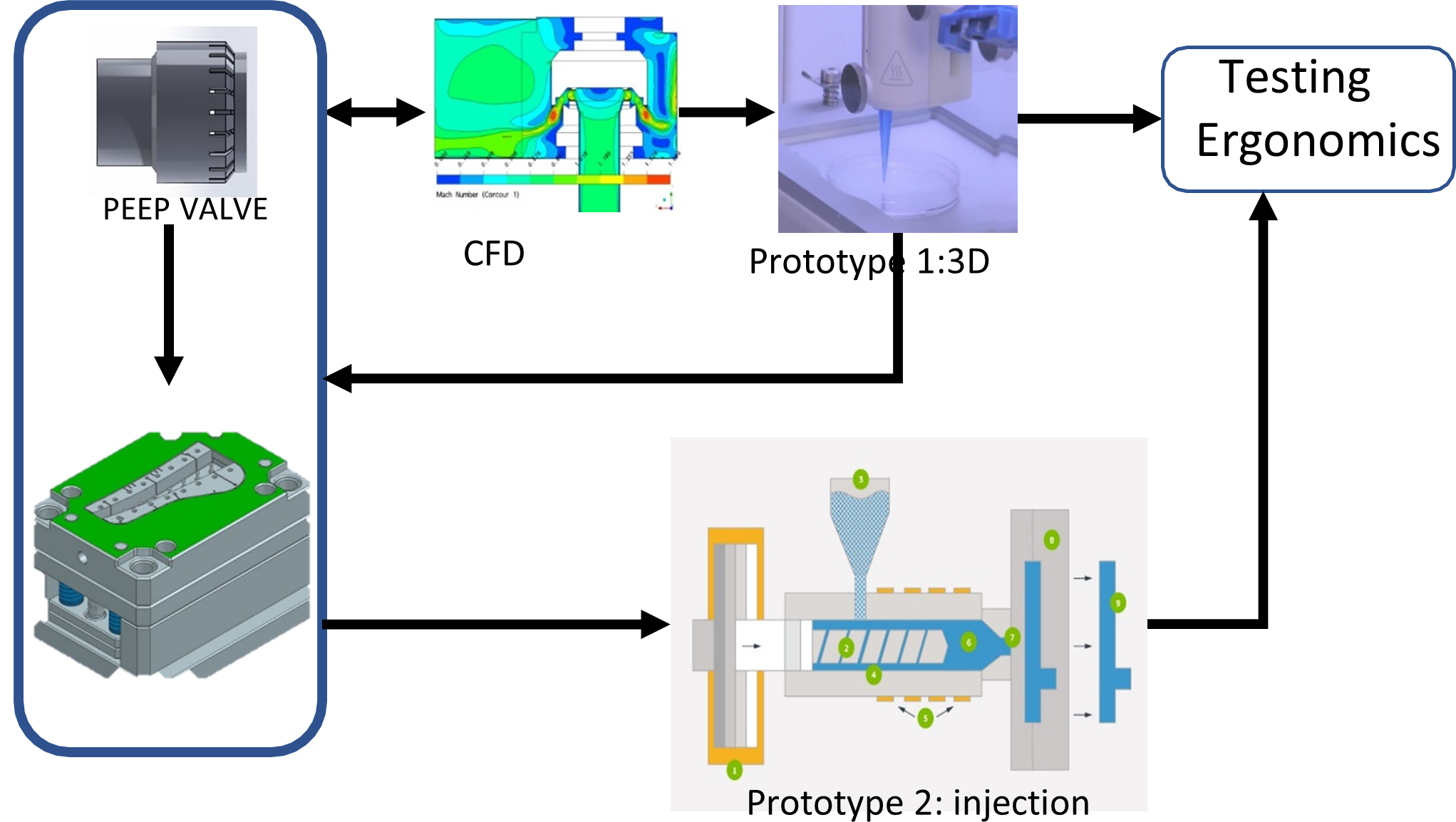
Simscale computational code was employed to characterise the two valves designed using the finite volume method. The code solves the turbulence in the valve associated with the patient exhalation air flow conditions. K-omega (𝑘 − 𝑤 𝑆𝑆𝑇)(Menter, 1994), a Reynolds average Navier- Stocks (RANS) turbulent closure was used to capture the turbulent flow characteristics of the exhalation air. 𝑘 − 𝑤 𝑆𝑆𝑇 captures effectively the airflow from the human respiratory system (Faizal et al., 2020;Srivastav et al., 2018).
The governing equation of unsteady compressible flow is:

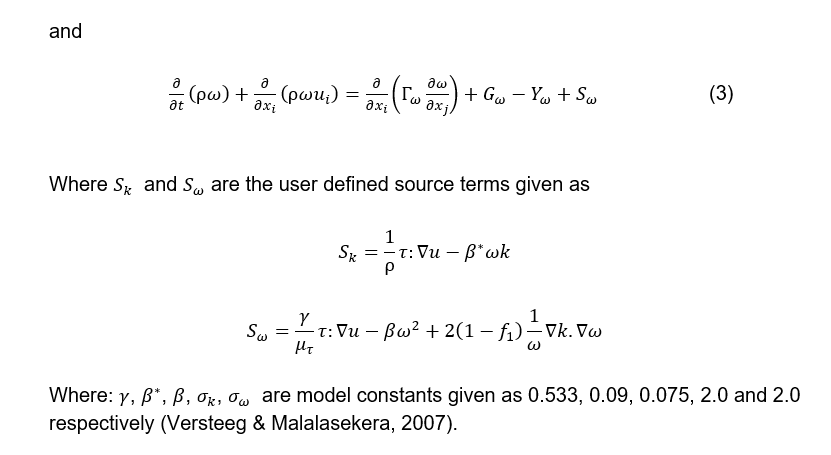
i. Computational domain and grid generation
Ability to effectively capture the turbulent flow characteristics depends on the size of the computational domain and its accurate discretisation into small cell volume (elements). The size of the domain downstream (5D x 10D downstream and 1d x 10D upstream) was carefully selected to allow smooth transition of the flow downstream without high turbulence leading to back flow as shown in Figure 4. Where 'D' is the diameter of the upper unit of the valve and 'd' the diameter of the plug. To reduce the computational power and cost, half of the domain was discretised (Figure 5) to an orthogonal mesh quality of 0.78088 and cell count of 5.8 million. To effectively capture the flow physics, the mesh was made finer around the diaphragm as shown in Figure 5b.
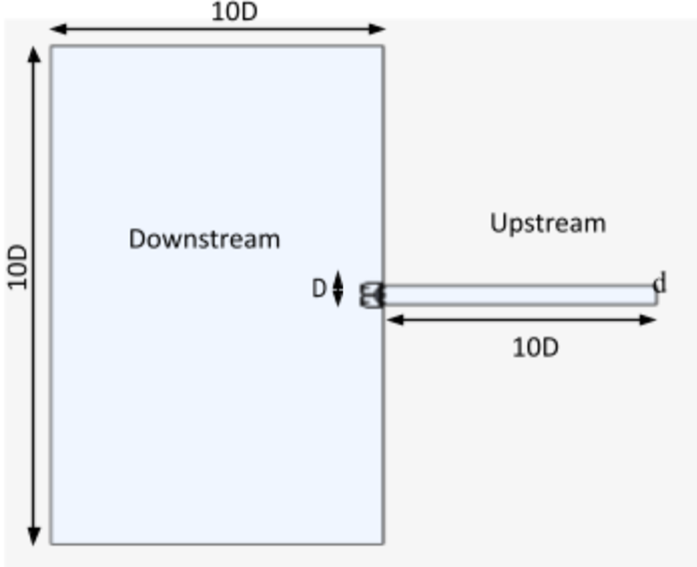
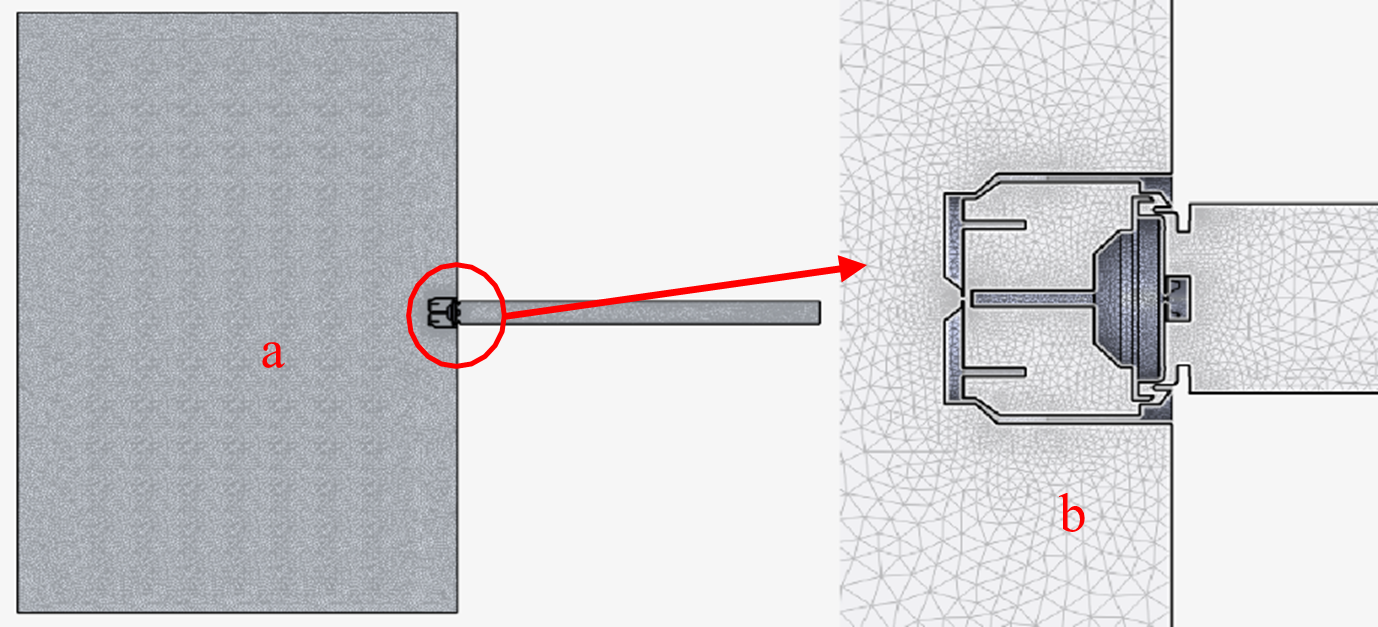
ii. Boundary condition
Boundary condition is an essential part of CFD for an accurate prediction of the flow physics. Pressure inlet and pressure outlet were set for the inlet and outlet boundary conditions. The pressure inlet represents the pressure of the exhalation air from the patient while the pressure outlet was measured downstream of the valve. The inlet pressure was simulated from 0 to 20 cmH2O.
The study entails the analysis of flow within the PEEP valve of an off-the-shelf and CATPUL PEEP valve developed for the merSETA medical device development project. The result presents both the qualitative and quantitative results of the pressure, flow velocity and the velocity vector of the both the Ambu PEEP and CATPUL PEEP valve.
i. Qualitative analysis results
This result section presents the pressure, velocity and velocity vectors contours which shows the flow pattern within the valves.
ii. Pressure contour plot
Figure 6a-d presents the XY plane contour plot of the exhalation airflow static pressure for 2 cmH2O at 1 mm and 2 mm valve opening, respectively. The figures show the pressure of the exhaled air flowing from the patients before opening the valve diaphragm, and the pressure after escaping through the opening before leaving the valve through the vent provided. The contour plots show that the pressure of the exhaled air is high. Significant pressure drop can be seen within the region of the diaphragm as the flow forces the diaphragm to open. From the figure, we can see that the pressure at all regions of the CATPUL PEEP valve [(Figure 6b and d) with opening of 2mm and 1mm, respectively] are 11973 Pa and 2148 Pa, respectively. Ambu valve (Figure 6a and c) recorded a maximum pressure of 1931 Pa and 2187 Pa at 2 mm valve opening. Although the pressure downstream is high compared to Ambu version, it does not cause any backpressure in the system as shown in Figure 8.
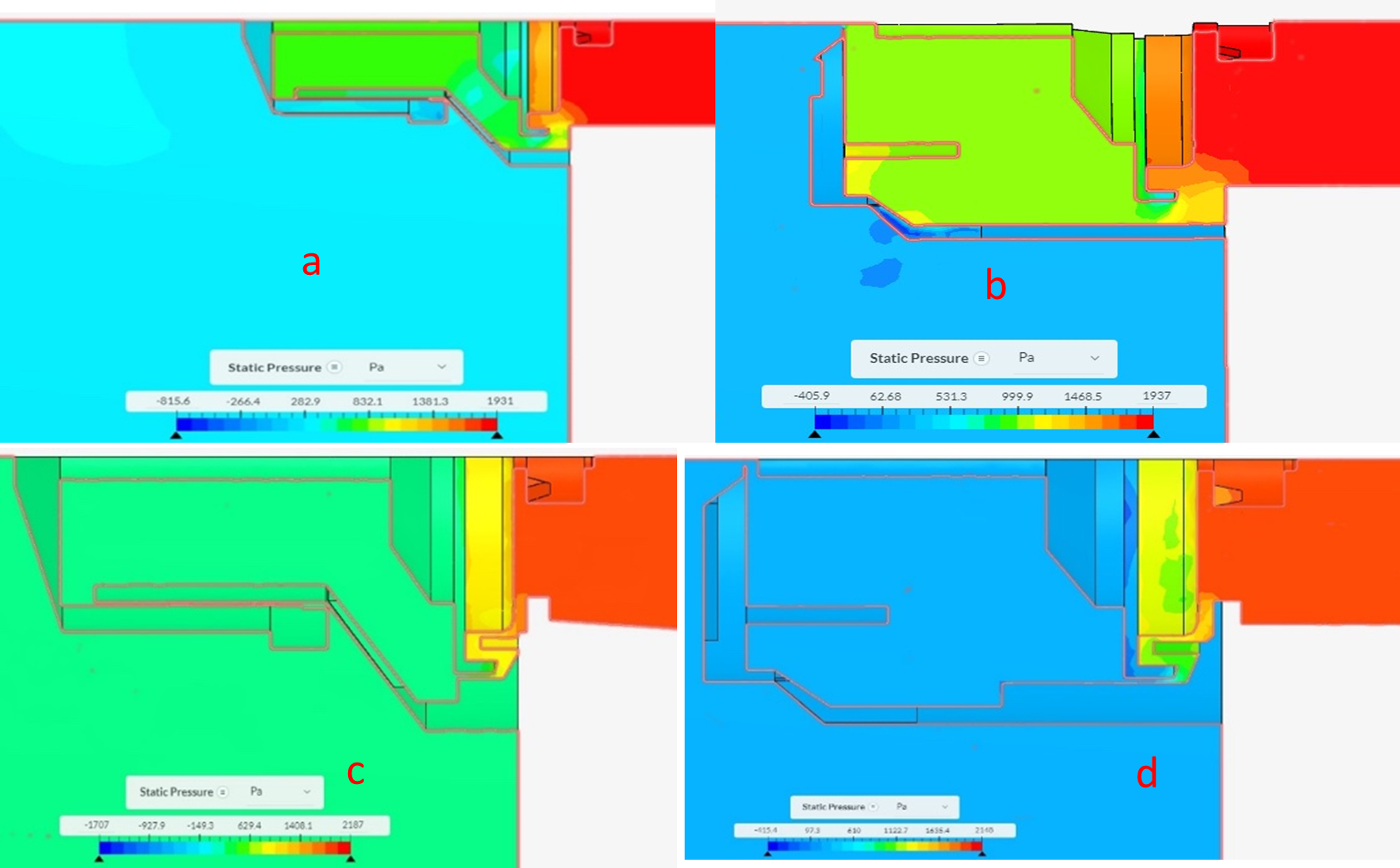
Figure 7 a-d presents the XY plane contour plot of the exhalation airflow velocity before opening the valve diaphragm and after escaping, leaving the diaphragm opening. Based on the parameters simulated, the figures showed the velocity downstream of the CATPUL valve is 29.77 m/s while that of the Ambu valve 29.73 m/s. The Ambu valve recorded a maximum flow velocity of 25.59 m/s at diaphragm region compared to 24.81 m/s recorded by the CATPUL valve. The lower velocity means a higher pressure for the CATPUL valve during operation, and this is advantageous.
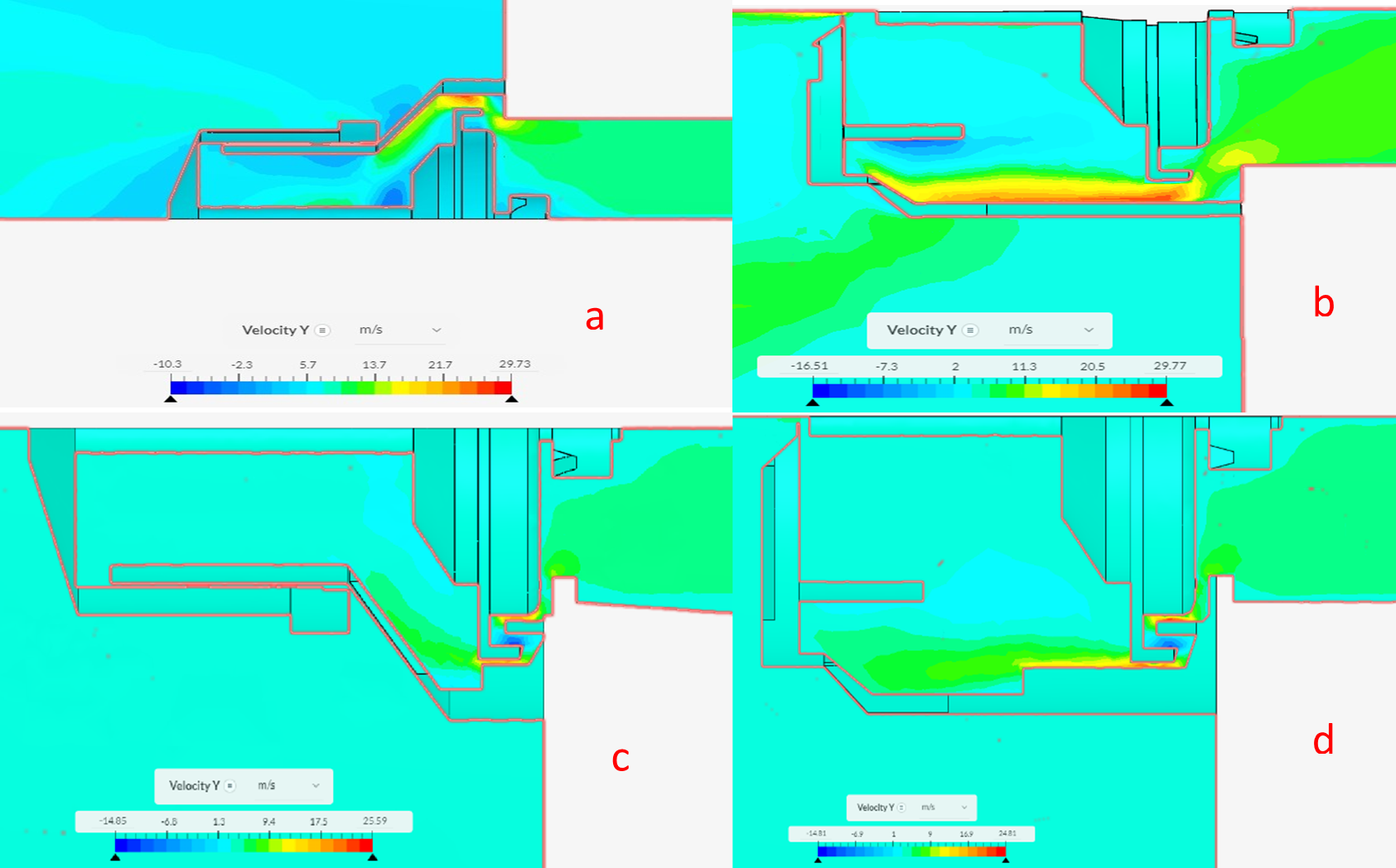
The flow stream of the exhaled air is presented in Figure 8. The velocity vector shows the flow direction and behavioural pattern of the air both downstream and upstream. It also clearly showed that the air flows seamlessly through the openings of the diaphragm without backflow. Also, the vectors indicate that the pressure within the valves is higher than the surrounding air, preventing it from entering the valve to create undesirable backpressure.

As presented in Figures 6, 7 and 8, the CATPUL PEEP valve design and analysis proves to be a good replacement for the Ambu counterpart. The CAPTUL valve gives a better performance as higher opening pressure is recorded. This means less work is required from the patient's respiratory system to open the valve during use. The velocity vector presented in Figure 8 shows that the CATPUL valve (Figure 8b) has a good flow and venting pattern. The flow circulation downstream of the valve is insignificant to cause backpressure capable of preventing the operation of the valve.
The computational study of the PEEP valve for patient's support is done comparing the performance of the Ambu and CAPTUL PEEP valve. 𝑘 − 𝜔 turbulent model was adopted to simulate the turbulent viscosity within the valve. The flow pattern from the two valves analysed shows a similar flow trend with a close flow parameter at different valve openings signifying different patients' breathing needs. The analysis shows that the pressure and the flow velocity of the two valves are closely matched with the CAPTUL valve, recording a higher operational pressure of 1937 Pa against 1931 Pa recorded by the Ambu valve.
The authors would like to acknowledge MerSETA, PtSA and NTIP staff for putting this project together and for the funding we enjoyed, UCT for facilitating this project to bring the level of exposure we had and, finally, AMTL staff for their technical assistance during the project.
Ashish, A., Unsworth, A., Martindale, J., Sundar, R., Kavuri, K., Sedda, L., & Farrier, M. (2020). CPAP management of COVID-19 respiratory failure: A first quantitative analysis from an inpatient service evaluation. BMJ Open Respiratory Research, 7(1), e000692.doi: 10.1136/bmjresp- 2020-000692
Bunting, L., Roy, S., Pinson, H., & Greensweig, T. (2020). A novel inline PEEP valve design for differential multi-ventilation. American Journal of Emergency Medicine, 38(10), 2045–2048.doi: 10.1016/j.ajem.2020.06.089
EPCM. (2020). Ventilators - An Overview within the Covid-19 Context - EPCM Holdings.https://epcmholdings.com/ventilators-an-overview-within-the-covid-19-context/
Faizal, W. M., Ghazali, N. N. N., & Khor, C. Y. (2020). Computational fluid dynamics modelling of human upper airway: A review. Computer Methods andPrograms in Biomedicine, 196, 105627. doi: 10.1016/j.cmpb.2020.105627
Hartung, J. C., Wilitzki, S., Thio-Lluch, M., Te Pas, A. B., Schmalisch, G., & Roehr, C. C. (2016). Reliability of Single-Use PEEP-Valves Attached to Self-Inflating Bags during Manual Ventilation of Neonates-An In Vitro Study. https://doi.org/10.1371/journal.pone.0150224
Hawkes, C. P., Dempsey, E. M., & Ryan, C. A. (2011). The Neopuff ’s PEEP valve is flow sensitive. Acta Paediatrica, International Journal of Paediatrics, 100(3), 360–363. doi: 10.1111/j.1651- 2227.2010.02086.x
Indiamart. (n.d.). CAD / CAM Designing Firm Plastic Injection Mould Tool Design, | ID: 22903903212. Retrieved December 26, 2021, from https://www.indiamart.com/proddetail/plastic-injection- mould-tool-design-22903903212.html
J.R. Boire, B. Roberts, T. Calow, M. J. & J. B. M. (2021). Flow meter, PEEP valve development and performance testing for use in a volume-controlled emergency use ventilator (EUV-SK1). CMBEC44. https://proceedings.cmbes.ca/index.php/proceedings/article/view/929/901
Mason, P. (2014). Rationale for including PEEP valves in extended care of critically ill casualties Phillip Mason, MD.
McEvoy, M. (2020). Why PEEP? - EMS Airway.https://www.emsairway.com/2020/06/02/why- peep/#gref
Meara, K. (2020). Existing Treatment Saves the Lives of Covid-19 Patients. https://www.contagionlive.com/view/existing-treatment-saves-the-lives-of-covid-19-patients
Menter, F. R. (1994). Two-equation eddy-viscosity turbulence models for engineering applications. AIAA Journal, 32(8), 1598–1605.doi: 10.2514/3.12149
Protolabs. (n.d.). Plastic Injection Moulding, Rapid Prototyping | Protolabs. Retrieved August 23, 2021, from https://www.protolabs.co.uk/services/injectionmoulding/plastic-injection-moulding/
PtSA. (2020). PtSA News Newsletter of the Production Technologies Industry in South Africa Sponsored by Intratech (Pty) Ltd.
Roelf, W. (2020). South Africa produces its first ventilators to fight COVID-19 | Reuters.https://www.reuters.com/article/us-health-coronavirus-safrica-ventilatoridUKKCN24W1VD
Schutz, E. (2020). COVID-19: SA’s looming ventilator shortage•Spotlight. https://www.spotlightnsp.co.za/2020/04/06/covid-19-sas-loomingventilator- shortage/
Song, X., Cui, L., Cao, M., Cao, W., Park, Y., & Dempster, W. M. (2014). A CFD analysis of the dynamics of a direct-operated safety relief valve mounted on a pressure vessel.
Srivastav, V. K., Paul, A. R., & Jain, A. (2018). Capturing the wall turbulence in CFD simulation of human respiratory tract. https://doi.org/10.1016/j.matcom.2018.11.019
Versteeg, H. K., & Malalasekera, W. (2007). An Introduction to Computational Fluid Dynamics. In World Wide Web Internet And Web Information Systems (Vol. 1).doi:10.2514/1.22547 Xinhua. (2020). Rwandan engineers develop first locally made ventilator - Xinhua | English.news.cn. http://www.xinhuanet.com/english/2020-04/21/c_138996664.htm